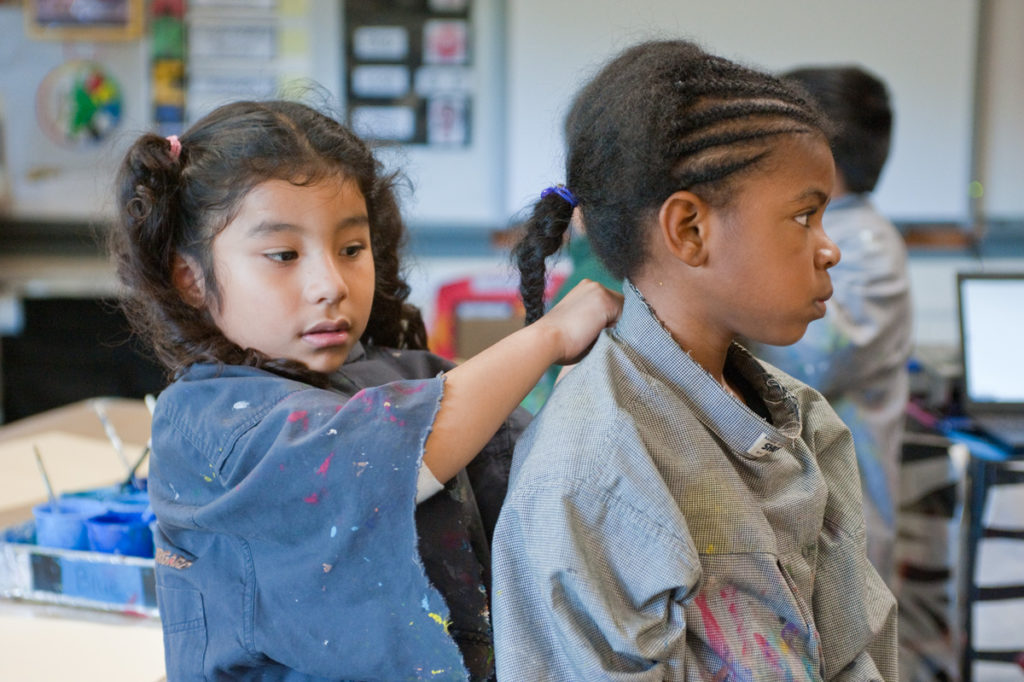
Thirty years ago, I went into my first classroom knowing about curriculum, interesting new ways to teach math and reading, and how to get terrific materials. I had spent the summer in a lively workshop, building, planning, and collecting. I set up my first grade room in centers with tri-wall dividers I had constructed myself. I had an easel in the art corner. I had a salt-water aquarium in the science center. I had over twenty new books in the library and all different shapes and colors of pasta in the math center. On the first day of school, I surveyed an inviting and rich learning environment. I was proud of it all.
I will never forget what Grady and Jerome and Michelle did to that room in the first week. The paint from the easel went straight onto Jerome, who then went straight to the principal’s office. Pockets were heavy with pastas, which were eaten raw, thrown, and stepped on, but not sorted or classified. The salt-water aquarium soon resembled the Meadowlands Swamp, a repository for just about everything. And rather than the eager and busy sighs of intent learners, there were whines and whimpers:
“Teacher, LOOK.”
“Teacher, he broke my pencil.”
“Teacher, what do we do now? Is it time to go home?”
It was a disaster. I felt personally wronged. I blamed the children. I blamed the school. I blamed everyone and anyone. I cried. I knew that I had to quit or I had to learn to run a classroom. In that crisis, I decided to learn. I cleaned up the mess. I junked the dividers. I observed other teachers—experienced teachers who still smiled. I began again. From that awful beginning came the greatest insight of my teaching life: A teacher can teach children to behave.
Unruly Jerome, “Make me” Annie, Sean of the Spitball Hall of Fame . . . the fights before and after school, the lunchroom frenzies, the boots that Lee denies he put in the toilet . . . the notes, the secrets, the cliques . . . the ragged transitions, the minimal effort on assignments. Teachers face enormous pressures. It is a struggle just to survive as a proud teacher of today’s children in schools that may lack even the basics. It is a challenge to help children grow up to be decent and kind and to retain faith in ourselves, our children, and our expectations. To meet these challenges, we need to know how to manage a classroom. We need to know how to pass on an affection for moral and ethical behavior.
Behaving in a moral and ethical way requires extending beyond the domain of self. This is a particularly urgent need in today’s world. We need to find connections to others and to feel ourselves members of many groups—intimate groups, community groups, and a world group. These connections and responsibilities need to be taught. We need to teach children to give care as well as to receive care. We must help them learn to contribute, to want to contribute, to believe that they have something vital to contribute.
“You have a gift to give,” I sometimes inform children as I seek their help in including someone it’s easier to ignore. There is a clear sense of self-worth and well-being when children show the ethic of caring. Even though it’s seldom spontaneous, it improves the world, and “I,” at six or ten or forty, did that improving.
We teach children to show the ethic of caring each day when we expect them to:
We go into teaching prepared to teach reading, math, writing, and social studies. We prepare for subjects. When I have to stop a lesson to remind Cindy not to interrupt, to address the sarcastic remarks David made to Patty (who gave a wrong answer), or to quiet the voices of students not part of my group, I clench my teeth and mutter about “wasting time.” If only I had the good class!
I do love to teach reading, writing, and math.
I love to help children decode new words, to share discussions about fictional characters, and to help them compose a thoughtful essay.
But I have also grown to appreciate the task of helping children learn to take better care of themselves, of each other, and of their classrooms. It’s not a waste. It’s probably the most enduring thing that I teach. In a world filled with global violence and threats of environmental devastation, where drugs and guns are easily available, learning to be more decent and to build caring communities is hardly a waste of time.
—Adapted from Teaching Children to Care by Ruth Sidney Charney